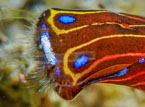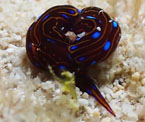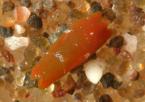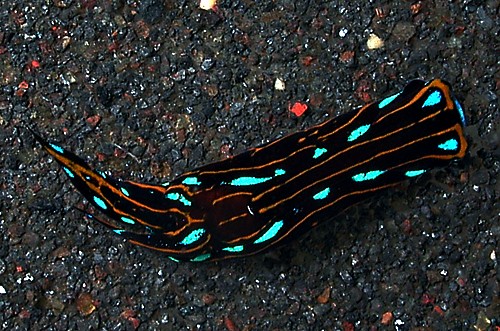| Home |
| Acknowledgments |
| Conventions |
| Glossary |
| Maps |
| References |
| Links |
| Articles |
| Thumbnails |
| Species
list |
| Family |
| Next
species |
Additional Photos

underside

sensory bristles

with white flecks

young, 2.8 mm

mating

probable food worm
_______________
GALLERY

Chelidonura alisonae Gosliner, 2011

| Maximum size: about 13 mm
(excluding "tail"). Identification: This is a dark brown to black species marked with orange lines and iridescent blue spots. Two blue spots on top of the head are enclosed by orange loops and the underside is reticulated with orange. The sides are decorated with rows of blue spots (the number, apparently, increasing with age) and the notum is variably flecked with white. Natural history: Chelidonura alisonae is a common diurnal species found in protected to exposed locations. It occurs in rocky habitats at depths of 1-11 m (3-35 ft). It appears to feed on the small acoelomate flatworm Convolutriloba longifissura. (Note 1) A fringe of sensory hairs at the front of the head is used to detect prey and it secretes a yellowish fluid when disturbed. In dishes, its egg masses are small, irregular, white clumps composed of an irregular string. However, it is likely that they remain sack-like when laid in the field where their sticky surfaces can collect detritus for reinforcement. Hatching occurs in about four days in the laboratory. Distribution: Big Island, Maui, Molokai, Oahu, Kauai, French Frigate Shoals, Pearl & Hermes Reef and Midway (also Johnston Atoll): widely distributed in the central Pacific; also in the eastern Pacific. Taxonomic notes: This species is illustrated as a color form of Chelidonura hirundinina in Kay, 1979 (right hand drawing) and Bertsch and Johnson, 1981. (Note 2) It is illustrated in the inset photo under C. hirundinina in Hoover, 2006 and given its own entry in the 2019 printing as "Alison's swallowtail slug". It was named after Dr. E. Alison Kay. Photo: CP: 10 mm: found by PF; Maalaea Bay, Maui; Oct 21, 2002. Observations and comments: Note 1: Several times in 1998 and 2002 animals were placed in dishes with 1.5-2 mm specimens of Convolutriloba longifissura (tentatively listed by Poulter as Convoluta sp. in section two of Reef and Shore Fauna of Hawaii, 1987). They fed readily on the worms but had a much slower feeding strike than either Chelidonura hirundinina or Biuve cf. fulvipunctata allowing the details to be easily seen. The pharynx was everted sufficiently to form a short tube and the worm was sucked in "spaghetti-fashion". The Chelidonura struck immediately on contact with the worms and showed no sign of regurgitation or rejection (unlike B. cf. fulvipunctata which engulfed, then regurgitated and C. hirundinina which tested, then rejected in some cases). It's my subjective impression that the worms showed a stronger aversive response to contact with Chelidonura alisonae than with the other two Chelidonura spp. So, there's a good chance that C. alisonae is the species that actually feeds on Convolutriloba longifissura in the field. Note2: Though held in dishes with C. hirundinina on many occasions, no sign of copulation between the two has been observed in contrast to many instances of copulation within the species. This supports the distinction between them. |
| Thumbnails |
Species
list |
Family | Next species | Top |